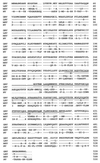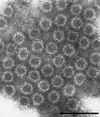Expression and self-assembly of Grimsby virus: antigenic distinction from Norwalk and Mexico viruses
- PMID: 9874680
- PMCID: PMC95676
- DOI: 10.1128/CDLI.6.1.142-145.1999
Expression and self-assembly of Grimsby virus: antigenic distinction from Norwalk and Mexico viruses
Abstract
A cDNA obtained from Grimsby virus (GRV), a Norwalk-like virus, purified from a stool sample of a symptomatic adult associated with a gastroenteritis outbreak in the United Kingdom, was used to obtain the complete nucleotide sequence of the second open reading frame (ORF2). The ORF2 sequence of GRV predicts a capsid of 539 amino acids (aa) which exhibits aa identities of 96% to Lordsdale virus, 67% to Mexico virus (MXV), and 43% to Norwalk virus (NV). The GRV capsid protein was expressed in insects cells by using a recombinant baculovirus, and the resulting virus-like particles (VLPs) possessed a protein with an apparent molecular weight of 58,000. Hyperimmune antisera raised against purified GRV, MXV, and NV VLPs were tested in an indirect enzyme-linked immunosorbent assay (ELISA) against GRV, NV, and MXV VLPs, revealing that GRV is antigenically distinct from both NV and MXV. The antigenic specificity of the GRV-hyperimmune antiserum was confirmed in an antigen capture ELISA using GRV-, NV-, or MXV-containing fecal specimens. The expression of the GRV capsid protein has, for the first time, allowed the antigenic comparison of three distinct recombinant Norwalk-like viruses.
Figures



Similar articles
-
Study of Norwalk virus and Mexico virus infections at Ga-Rankuwa Hospital, Ga-Rankuwa, South Africa.J Clin Microbiol. 1997 Sep;35(9):2381-5. doi: 10.1128/jcm.35.9.2381-2385.1997. J Clin Microbiol. 1997. PMID: 9276420 Free PMC article.
-
Baculovirus expression and antigenic characterization of the capsid proteins of three Norwalk-like viruses.Arch Virol. 2002;147(1):119-30. doi: 10.1007/s705-002-8306-5. Arch Virol. 2002. PMID: 11855626
-
Prevalence of human calicivirus infections in Kenya as determined by enzyme immunoassays for three genogroups of the virus.J Clin Microbiol. 1998 Nov;36(11):3160-3. doi: 10.1128/JCM.36.11.3160-3163.1998. J Clin Microbiol. 1998. PMID: 9774557 Free PMC article.
-
[Rapid and efficient detection method of Norwalk virus].Nihon Rinsho. 2002 Jun;60(6):1181-7. Nihon Rinsho. 2002. PMID: 12078092 Review. Japanese.
-
Genetic and antigenic diversity of human caliciviruses (HuCVs) using RT-PCR and new EIAs.Arch Virol Suppl. 1996;12:251-62. doi: 10.1007/978-3-7091-6553-9_27. Arch Virol Suppl. 1996. PMID: 9015122 Review.
Cited by
-
Identification of an epitope common to genogroup 1 "norwalk-like viruses".J Clin Microbiol. 2000 Apr;38(4):1656-60. doi: 10.1128/JCM.38.4.1656-1660.2000. J Clin Microbiol. 2000. PMID: 10747162 Free PMC article.
-
Molecular cloning, expression, and antigenicity of Seto virus belonging to genogroup I Norwalk-like viruses.J Clin Microbiol. 2000 Sep;38(9):3492-4. doi: 10.1128/JCM.38.9.3492-3494.2000. J Clin Microbiol. 2000. PMID: 10970413 Free PMC article.
-
Cross-reactivity among several recombinant calicivirus virus-like particles (VLPs) with monoclonal antibodies obtained from mice immunized orally with one type of VLP.J Clin Microbiol. 2002 Jul;40(7):2459-65. doi: 10.1128/JCM.40.7.2459-2465.2002. J Clin Microbiol. 2002. PMID: 12089262 Free PMC article.
-
Expression and self-assembly in baculovirus of porcine enteric calicivirus capsids into virus-like particles and their use in an enzyme-linked immunosorbent assay for antibody detection in swine.J Clin Microbiol. 2001 Apr;39(4):1487-93. doi: 10.1128/JCM.39.4.1487-1493.2001. J Clin Microbiol. 2001. PMID: 11283075 Free PMC article.
-
Characterization of a broadly reactive monoclonal antibody against norovirus genogroups I and II: recognition of a novel conformational epitope.J Virol. 2007 Nov;81(22):12298-306. doi: 10.1128/JVI.00891-07. Epub 2007 Sep 12. J Virol. 2007. PMID: 17855545 Free PMC article.
References
-
- Dingle K E, Lambden P R, Caul E O, Clarke I N. Human enteric Caliciviridae: the complete genome sequence and expression of virus-like particles from a genetic group II small round structured virus. J Gen Virol. 1995;76:2349–2355. - PubMed
-
- Estes M K, Hardy M E. Norwalk virus and other enteric caliciviruses. In: Blaser M J, Smith P D, Ravdin J I, Greenberg H B, Guerrant R L, editors. Infections of the gastrointestinal tract. 1st ed. New York, N.Y: Raven Press, Ltd.; 1995. pp. 1009–1034.
-
- Estes M K, Atmar R L, Hardy M E. Norwalk and related diarrhea viruses. In: Richman D, Whitley R, Hayden F, editors. Clinical virology. New York, N.Y: Churchill Livingstone; 1997. pp. 1073–1095.
-
- Gray J J, Green J, Gallimore C, Lee J V, Neal K, Brown D W G. Mixed genogroup SRSV infections among a party of canoeists exposed to contaminated recreational water. J Med Virol. 1997;52:425–429. - PubMed
-
- Green, J., J. Vinjé, C. Gallimore, M. P. Koopmans, A. Hale, and D. W. G. Brown. Capsid diversity among small round structured viruses. Submitted for publication.
Publication types
MeSH terms
Substances
Associated data
- Actions
Grants and funding
LinkOut - more resources
Full Text Sources
Other Literature Sources

